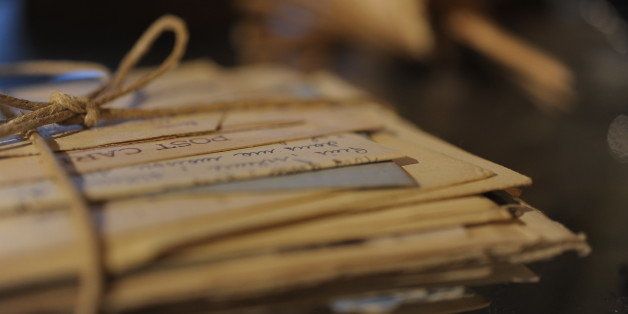
Some weeks ago, I sent a copy of my novel, The Divorce Papers (Crown, $25.00), to a friend. An epistolary novel about a young lawyer roped into handling a messy and contentious divorce, it is told entirely through letters, emails, invitations, cards, newspapers articles, law cases, and statutes. My friend emailed me to say it had arrived. "I've always loved reading other people's mail," she wrote. Exactly. In writing the novel, I wanted readers to feel they were reading over the shoulder of the young lawyer as she went about her days, juggling clients, colleagues, friends, boyfriends, and parents.
Since early adolescence, I've been reading epistolary novels, enjoying their dual nature. On the one hand, there's the direct, immediate contact with the characters, all of them currying favor, their voices importuning: listen to me, believe me. On the other, there's the circuitousness and obliqueness of the storytelling, challenging readers' credulity, arousing their suspicions.
My experiences with the epistolary novel have run the gamut, from its distinguished provenance to contemporary reinventions. The ones below shaped my thinking about the genre, revealing its possibilities and encouraging my own experiments.
My maiden experience was with Daddy Long Legs, Jean Webster's 1912 bestseller about an orphaned girl who is saved from the workhouse and sent to college by an anonymous guardian, the eponymous "Daddy Long Legs." The book, all of it letters from the girl to "Daddy," has great charm. It also has an "ick" factor. At the end, the orphan is planning to marry "Daddy," who has been cavorting in the novel up till then as the uncle of a friend. This revelation in her final letter, this merging of identities, was an unexpected, uncomfortable, and undesired moment for a 12-year-old. My brain grudgingly acceded -- it made sense that an orphan might want to marry a father-uncle-husband -- but my heart rebelled. Was that Princeton boyfriend just a straw man? It was like Jo marrying the German professor instead of Laurie. All wrong.
My heroic experience was with Clarissa, Samuel Richardson's 1748 novel, a 1,500-page saga of dueling letters between a virgin and her seducer-rapist, both of them obsessive and prolix. Half way through, I was longing for one of them to die. It was clearly the only way out for all of us. Still I persevered, largely for reasons of self-respect. My perseverance brought rewards: it made me a more patient reader, more sensitive to voice and point of view, less willing to abandon hard texts.
My classical experience was with Dracula, Bram Stoker's 1897 gothic horror story of a breathless cross-continental chase to rescue a young wife from the lethal jaws of an evil and irresistible Transylvanian vampire. Made up of letters, journal entries, newspaper articles, and ships' log entries, the novel is all about sex without saying so. The reader finds herself pulling for the vampire; he is by far the most attractive male in the book. Later vampire novels, including the teenage Twilight Saga, have more than made up for Stoker's Victorian circumspection, but none has given us as brilliant, scary, seductive, and thrilling a fiend as Count Dracula.
My playful experiences were with two fictions which reimagined the genre in witty and unusual ways. The first, by the screenwriter Geoffrey Kerr, writing in the original Vanity Fair magazine, is an epistolary short story. Hilarious and oddly affecting, Kerr's story is told in a series of 42 personal checks over a period of 28 years, from 1903 to 1931. In chronological order, they take the protagonist, clearly a cad, from cradle (Goosie Gander Baby Shoppe, $148.50) to grave (Hollywood Mortuary, $1280), with payoffs in between to, among others, a military school, a girl named Daisy, a bookie, a lingerie shop, a florist, and the Reno Municipal Court. The second is Leann Shapton's Important Artifacts and Personal Property from the Collection of Lenore Doolan and Harold Morris, a fictional auction catalogue of property to be sold in the wake of a couple's break-up. The usual detritus of a long-term relationship is on display and through postcards, photos, notes, invitations, letters, books, clothes, CDs, Shapton artfully and movingly charts its rise and fall.
Coming to the end of this survey, I see that all the books I've written about are love stories of one sort of another, even Kerr's cynical check saga. The epistolary novel, having rid itself of the single narrator and unifying point of view, offers an irresistible platform for an amorous tale. The intimacy of correspondence invites confession, as well as seduction, recklessness, betrayal, indiscretion, all the poisoned arrows in Cupid's quiver. Still, even when its themes are heart-breaking, the epistolary novel is a mischievous one: exploiting the instability of an unmediated plot, exposing its characters' unreliability and egotism, teasing its readers with indirection and misdirection. As my friend knew, one of the great pleasures of reading an epistolary novel is the voyeuristic one, the frisson of violating others' privacy, of peering through their windows, prying open their safes, hacking into their email, eavesdropping on their calls, following them into hotels and bars, in short doing things most of us would never do outside the pages of a book.